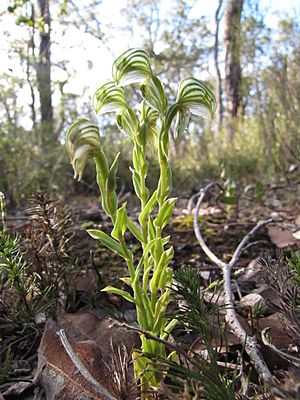Banded greenhood facts for kids
Quick facts for kids Banded greenhood |
|
|---|---|
 |
|
| Scientific classification | |
| Genus: |
Pterostylis
|
| Species: |
vittata
|
| Synonyms | |
|
|
The Banded Greenhood (Pterostylis vittata) is a special type of orchid. It's also called the Green-banded Greenhood. This plant grows only in the south-west part of Western Australia. It's known for its unique green flowers with darker stripes.
Contents
About the Banded Greenhood Orchid
The Banded Greenhood is a plant that grows from an underground tuber, like a small potato. It's a perennial herb, meaning it lives for more than two years. It also loses its leaves each year, which is called being deciduous.
What Does the Plant Look Like?
When the plant is not flowering, it has a group of leaves shaped like a circle, called a rosette. This rosette has about three to seven leaves. Each leaf is about 1 to 3 centimetres (0.4 to 1.2 inches) long. The rosette sits on a short stalk, about 2 to 6 centimetres (0.8 to 2.4 inches) tall.
When the plant flowers, it grows a tall stem. This stem can be 20 to 45 centimetres (8 to 18 inches) high. It has three to fourteen leaves along the stem. These stem leaves are about 2 to 5 centimetres (0.8 to 2 inches) long.
The Unique Flowers
The Banded Greenhood can have up to twenty-five flowers on one stem. These flowers are a see-through green color with darker green stripes. Each flower is about 1.2 to 1.5 centimetres (0.5 to 0.6 inches) long. They are also about 0.8 to 1 centimetre (0.3 to 0.4 inches) wide.
The top part of the flower, called the "galea," looks like a hood. It covers the central part of the flower. The side parts of the flower, called sepals, point downwards. They are joined at their base.
The most interesting part is the labellum. This is a special lip-like part of the flower. It is green and hairy, looking a bit like an insect. It's about 4 millimetres (0.16 inches) long. If you touch it, it quickly flicks upwards! This movement helps with pollination.
When Does it Flower?
You can see the Banded Greenhood in flower from May to September.
How the Banded Greenhood Got its Name
The Banded Greenhood was first officially described in 1840. A scientist named John Lindley gave it the scientific name Pterostylis vittata. He published his description in a book called A Sketch of the Vegetation of the Swan River Colony.
The word vittata comes from Latin. It means "striped" or "banded." This name perfectly describes the striped hood of the flower.
Where the Banded Greenhood Lives
The Banded Greenhood orchid grows in the south of Perth, Western Australia. You can find it as far east as Balladonia. It likes to grow in forests, woodlands, and heathlands. In the eastern parts of its range, it often grows on rocky granite outcrops.
It was once thought that this orchid also grew in South Australia and Victoria. However, scientists now believe those plants were actually a different species called Pterostylis sanguinea.
Is the Banded Greenhood Protected?
The Government of Western Australia's Department of Parks and Wildlife has classified Pterostylis vittata as "not threatened." This means it is not currently at risk of disappearing.

